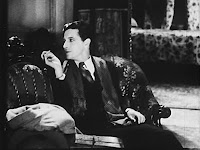You may have heard about the 1944 20th Century Fox film starring Merle Oberon, Georges Sanders and Laird Cregar, or the 2009 film where Simon Baker plays the title role. Marie Belloc Lowndes's novel was also adapted with other titles such as Man in the Attic.
 The film I mean is a little known adaptation though it stars the original lodger Ivor Novello only five years after the release of Alfred Hitchcock's masterpiece. It is also called The Lodger, but it was released in a cut version under the title The Phantom Fiend in the USA, a title shared with the 1961 German film Im Stahlnetz des Dr. Mabuse. To add to the confusion, the film was apparently called Meurtre in France (among other titles) which is also the French title of Alfred Hitchcock's Murder!.
The film I mean is a little known adaptation though it stars the original lodger Ivor Novello only five years after the release of Alfred Hitchcock's masterpiece. It is also called The Lodger, but it was released in a cut version under the title The Phantom Fiend in the USA, a title shared with the 1961 German film Im Stahlnetz des Dr. Mabuse. To add to the confusion, the film was apparently called Meurtre in France (among other titles) which is also the French title of Alfred Hitchcock's Murder!.Maurice Elvey directed the sound version. Although it is nowhere near as brilliant as the silent version, a few shots are reminiscent of the Hitchcock style. Among them are the numerous ones focusing on the ever-present stairs. The use of shadows is particularly interesting. The removal of the portraits, the sinister entrance of the lodger (although not as hyperbolic) are all elements carried over from the old film to the new one.
But there are new ideas : the escape of the lodger is arguably more realistic (no angry mob here) and this film adds a scene with handcuffs that Hitchcock may have liked. The boyfriend role was changed from policeman to journalist which adds a new (if not necessarily better) dimension. More importantly, it is played by Jack Hawkins (Ben Hur, Lawrence of Arabia, etc.) in one of his first roles.
Sound does add value to the film which took advantage of its assets with the multi-talented star. Ivor Novello was a composer and sang (he also wrote the famous "Tarzan, Jane, Tarzan, Jane..." dialogue from Tarzan the ape man). So the lodger is now a musician and plays various instruments that convey his feelings better than words (a common mistake in early talkies is to make characters talk forever), and sweeten the love scenes, making it easier for the viewer to understand how the girl can fall in love with this otherwise perfect stranger.
Hearing Ivor Novello's voice makes all the difference in the perception of the character. The man still retained mannerism that was already very apparent in the silent version. But Hitchcock's interest in homosexuality (and since Novello was so obviously gay) made him accentuate that by staging shots with flowers around the actor as an in-joke. Novello came off as an effeminate young matinée idol, whereas in the sound version, he was pushing forty and spoke in a baritone voice with a thick eastern accent (not the best idea of the film) which toughened the character.
In spite of that, the first approach still made the character look more mysterious and the attempt to "open up" the script in the remake beyond just the house is a poor choice considering the atmosphere. In that respect, the park scene, filmed in broad daylight, where the supposedly menacing character makes idle conversation with the girls is clearly a mistake.
Still, the film is quite enjoyable overall and the end is very different from Hitchcock's version (even though none are faithful to the novel).
Don't forget to click "like" on the Facebook page for more.
That's all for today, folks!






No comments:
New comments are not allowed.